A communications network is a system that enables the exchange of data and information between devices, users, and applications. It consists of various components, including:
Transmission Media: This includes physical media like cables (fiber optics, coaxial, twisted pair) and wireless channels (radio waves, microwaves).
Networking Devices: Routers, switches, hubs, and access points facilitate data transfer, manage traffic, and connect different segments of the network.
Protocols: These are rules governing data transmission, ensuring reliable communication. Common protocols include TCP/IP, HTTP, and FTP.
Network Topologies: This refers to the layout of the network, which can be star, ring, bus, or mesh, affecting performance and scalability.
Services: Networks support various services such as voice communication (VoIP), video conferencing, and internet access.
Security: Measures like firewalls, encryption, and authentication are crucial for protecting data and maintaining privacy.
Communications networks can be classified into various types, including local area networks (LANs), wide area networks (WANs), metropolitan area networks (MANs), and the internet, each serving different purposes and geographic scopes.
See more information: – network.sciencefather.com
Nomination : Nominate Now
Contact us : network@sciencefather.com

.png)


No comments:
Post a Comment